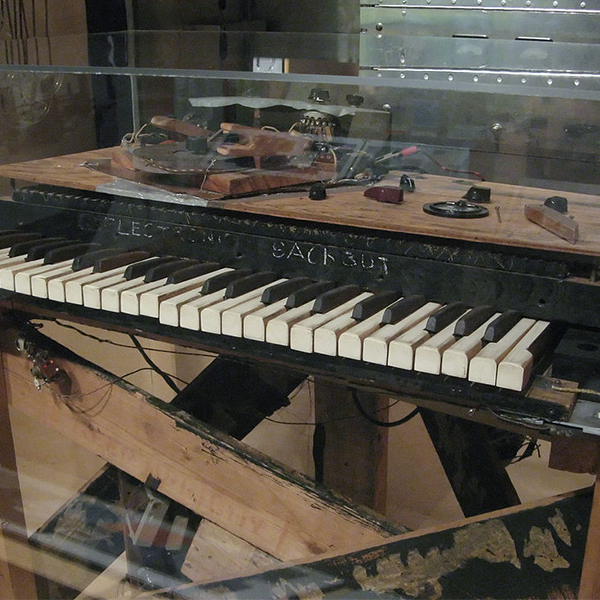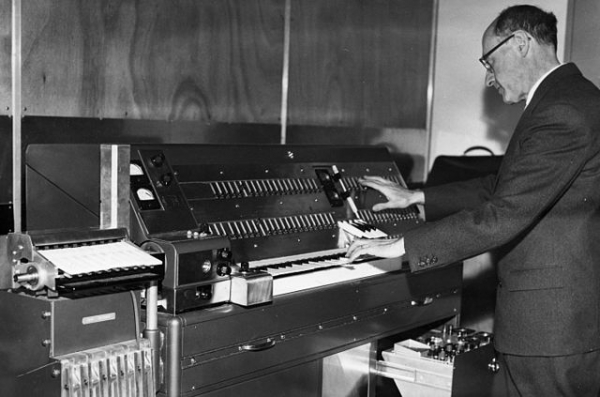Who Created the Electronic Synthesizer?

The Electronic Sackbut Synthesizer at the Canada Science and Technology Museum (Wikimedia Commons/David Carroll)

The Electronic Sackbut Synthesizer at the Canada Science and Technology Museum (Wikimedia Commons/David Carroll)
A Canadian researcher built the first voltage-controlled synthesizer in the 1940s.
Electronically synthesized music has been everywhere for a while. You can hear it in 1980s classics like Depeche Mode’s “Just Can’t Get Enough” or The Buggles’ “Video Killed the Radio Star.” In the 1990s, you could hear it in albums by Daft Punk and Bjork. More recently, you heard it in pop tunes by Katy Perry, in electronic remixes by Tiesto and in rap songs featuring DJ Snake and Lil Jon. It’s in just about any of Skrillex’s dubstep or Marshmello’s house beats.
Did you know there’s a strong Canadian connection to all that electronic music? Hugh Le Caine worked as an atomic physicist at the National Research Council (NRC). But he was most passionate about the physics of sound. Between 1945 and 1948, Le Caine built the very first voltage-controlled sound synthesizer. He called it the Electronic Sackbut Synthesizer.
Did you know?
A sackbut was a 15th-century musical instrument. It was an early version of the trombone, using a slide mechanism to change pitch. The sackbut provided a lower range of sounds than a trumpet.
A synthesizer is an electronic device that reproduces sound. It can imitate natural and familiar sounds like the trill of a bird or the drip of water in a pan. It can mimic acoustic musical instruments like pianos, violins and flutes. Synthesizers can even create completely original sounds that you can’t hear anywhere else.

Le Caine wanted to make an electronic musical instrument that a person could play in real time. The performer would be able to use directional pressures to change the background voltage. In turn, this would change the attributes of the sounds being produced.
The electronic sackbut only produced one note at a time. But performers could control that single sound in many ways. For example, they could vary the pressure they applied to the piano-style keys. Or they could push or pull the keys in different directions.
The force applied to the keys with the right hand determined the sound’s volume or loudness. Moving the keys from side to side changed the pitch. Pitch refers to the frequency of vibration. Performers could even create a vibrato by wiggling a key with their finger. A vibrato is a pulsating change in pitch.
The left hand operated pressure-sensitive finger pads. They changed different aspects of the sound waveform. Waveform refers to the shape of the sound wave over time. These changes altered the timbre of the sound. The timbre is what makes one sound distinct from another, even at the same volume and pitch. It’s what lets you distinguish the sound of a flute from the sound of a piano or a human voice.
Le Caine gave a number of public performances with the original electronic sackbut. He demonstrated the kinds of sounds and music it could create. These shows were so successful that the NRC gave him his own sound technology lab. He started working there full-time in 1954.
Between 1969 and 1971, Le Caine improved the devices that controlled timbre on the sackbut synthesizer. In 1971, he made a prototype of a commercial sackbut synthesizer using modern design techniques. But it was never mass-produced or sold to the public.
Did you know?
“Dripsody” was Hugh Le Caine’s most famous composition. It involved electronically manipulating and multiplying the sound made by a single drop of water.
Le Caine’s synthesizer was never a commercial success. But many of his other sound technologies were used in music labs during the 1960s and early 1970s. He personally helped establish the very first electronic music labs at Canadian universities. The lab at the University of Toronto opened in 1959. The one at McGill University opened in 1964. They were almost entirely equipped with sound technologies produced by Le Caine at the NRC. He also taught young composers of electroacoustic music.
Le Caine retired in 1974. By that time, he had developed over 20 different sound technologies. These included new instruments, a touch-sensitive keyboard and a variable speed multi-track tape recorder. Many of his innovations were ahead of their time. Some features he introduced didn’t find their way into commercial products until the late 1980s.
The next time you are listening to electronic music, remember the electronic sackbut synthesizer. You can thank Hugh Le Caine for these now-familiar sounds!
Starting Points
-
Do you have a favourite song that uses electronically-produced sounds?
-
Can you play an electronic instrument? What instrument? What do you like about its sound?
-
Do you think it is possible to differentiate between natural (acoustic) and electronic sounds in most music we listen to? Explain.
-
In what ways did Le Caine’s inventions influence music production, performance and music education?
-
What are some of the social and economic reasons that electronic music is so pervasive in society today?
-
What is sound? What determines the pitch of a sound? What determines the loudness or softness of a sound?
-
What is acoustic music? What features of acoustic musical instruments change the characteristics of the sound produced?
-
How is sound manipulated in electronic music?
-
How does waveform relate to the timbre of sound?
-
What is a design prototype? Why was the Electronic Sackbut Synthesizer considered a prototype?
-
How do LeCain’s inventions, like the Electronic Sackbut, demonstrate that science and technology is an iterative and dynamic process?
-
Do you know of any current technology that allows a composer or performer to record multi-tracks and manipulate the speed of sounds produced?
-
This article can be used to support teaching and learning of Technology & Engineering, Physics, Waves and Sound and Light related to sound waves. Concepts introduced include atomic physicist, synthesizer, acoustic, voltage, volume, pitch, frequency, vibrato, waveform, timbre, prototype, electroacoustic music, touch-sensitive, and variable speed multi-track.
-
After reading this article, teachers could have students complete a Concept Definition Web learning strategy for the concept of sound. Ready-to-use Concept Definition Web reproducibles are available in [Google doc] and [PDF] formats.
-
To help consolidate learning from the article, teachers could have students consider the consequences of Le Cain’s invention of the Electronic Sackbut Synthesizer using a Consequence Mapping Learning strategy. Ready-to-use Consequence Mapping reproducibles for this article are available in [Google doc] and [PDF] formats.
-
For an issues focus, teachers could have students explore the positive and negative aspects of electronic music using a Pros & Cons Organizer learning strategy. Ready-to-use Pros & Cons Organizer reproducibles are available in [Google doc] and [PDF] formats.
Connecting and Relating
-
Do you have a favourite song that uses electronically-produced sounds?
-
Can you play an electronic instrument? What instrument? What do you like about its sound?
-
Do you think it is possible to differentiate between natural (acoustic) and electronic sounds in most music we listen to? Explain.
Relating Science and Technology to Society and the Environment
-
In what ways did Le Caine’s inventions influence music production, performance and music education?
-
What are some of the social and economic reasons that electronic music is so pervasive in society today?
Exploring Concepts
-
What is sound? What determines the pitch of a sound? What determines the loudness or softness of a sound?
-
What is acoustic music? What features of acoustic musical instruments change the characteristics of the sound produced?
-
How is sound manipulated in electronic music?
-
How does waveform relate to the timbre of sound?
Nature of Science/Nature of Technology
-
What is a design prototype? Why was the Electronic Sackbut Synthesizer considered a prototype?
-
How do LeCain’s inventions, like the Electronic Sackbut, demonstrate that science and technology is an iterative and dynamic process?
Media Literacy
-
Do you know of any current technology that allows a composer or performer to record multi-tracks and manipulate the speed of sounds produced?
Teaching Suggestions
-
This article can be used to support teaching and learning of Technology & Engineering, Physics, Waves and Sound and Light related to sound waves. Concepts introduced include atomic physicist, synthesizer, acoustic, voltage, volume, pitch, frequency, vibrato, waveform, timbre, prototype, electroacoustic music, touch-sensitive, and variable speed multi-track.
-
After reading this article, teachers could have students complete a Concept Definition Web learning strategy for the concept of sound. Ready-to-use Concept Definition Web reproducibles are available in [Google doc] and [PDF] formats.
-
To help consolidate learning from the article, teachers could have students consider the consequences of Le Cain’s invention of the Electronic Sackbut Synthesizer using a Consequence Mapping Learning strategy. Ready-to-use Consequence Mapping reproducibles for this article are available in [Google doc] and [PDF] formats.
-
For an issues focus, teachers could have students explore the positive and negative aspects of electronic music using a Pros & Cons Organizer learning strategy. Ready-to-use Pros & Cons Organizer reproducibles are available in [Google doc] and [PDF] formats.
Learn more
A Nation of Tinkerers: How a Canadian University Shaped Electronic Music in North America (2016)
Article by Michael Rancic for Vice detailing the history of the University of Toronto’s Electronic Music Studio, Hugh Le Caine’s involvement in it, and they work that’s been done there over the years. Includes historical information, images, and videos. Note that this resource was also used as a reference.
The Hugh Le Caine Project (1999)
Listen to samples of musical compositions created by Hugh Le Caine and played on the electronic sackbut.
Frequency, Wave Shape and Pitch (2017)
Informative video (7:05 min.) from Walk That Bass detailing the different components of a sound wave and how it can be manipulated to create different sounds.
References
120years.net. (n.d.). The ‘electronic sackbut’ and the ‘sonde’. Hugh Le Caine. Canada, 1945.
Ingenium. (n.d.). Hugh Le Caine "electronic sackbut" synthesizer.
Young, G. (1999). Electronic sackbut (1945-1973). The Hugh Le Caine Project.